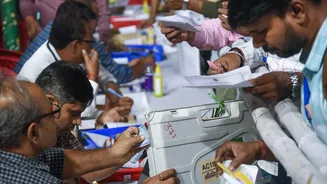Initial Reactions and Analysis
The Bihar election of 2025 drew varied reactions and comprehensive analyses immediately following the announcement of the results. Political analysts and commentators
meticulously examined the factors contributing to the election's outcome. Dipankar Bhattacharya offered a noteworthy assessment, labeling the results as 'abnormal' and attributing them to a trio of 'experiments.' This assessment triggered a wave of discussions and differing perspectives, leading to an extensive examination of electoral strategies, voter demographics, and broader political dynamics within the state.
Dipankar Bhattacharya's Perspective
Dipankar Bhattacharya's commentary emerged as a central point of reference for comprehending the election's unexpected results. His assertion that the outcome was a consequence of three distinct 'experiments' provided a concise framework for understanding the deviations from anticipated results. This perspective encouraged deeper scrutiny of the strategic shifts and political maneuvers throughout the election campaign. Analysts focused on dissecting these 'experiments,' aiming to determine their specific influences on voter behavior, campaign efficacy, and the overall trajectory of the election. This focused analysis aimed at understanding the essence of Bhattacharya's evaluation of the Bihar Election of 2025.
Unpacking the 'Experiments'
To fully comprehend the 'abnormal' results, it is essential to delve deeper into the nature of the three 'experiments' identified by Dipankar Bhattacharya. These might have comprised innovative campaign strategies, novel coalition formations, or unexpected shifts in political messaging. Each 'experiment' could have targeted specific demographic groups, focused on particular socio-economic issues, or used technological advancements to engage voters. Dissecting the implementation, impact, and ultimate effectiveness of these 'experiments' will give insights into the election's unexpected shifts and contribute to understanding how each choice swayed the voters' decisions. Such examination will bring more clarity about the broader political context and provide valuable lessons for future elections.
Campaign Strategies Examined
A detailed look into the campaign strategies employed by the different political parties is essential to grasping the election's dynamics. This examination would encompass a detailed assessment of the messaging, outreach programs, and resource allocation. Parties would have likely engaged in innovative methods to connect with voters, taking into account the state's diverse electorate. The strategies' effectiveness would have been influenced by factors such as the socio-economic conditions, regional affiliations, and the evolving political discourse. Analyzing the successes and failures of each party's campaign tactics provides a comprehensive understanding of the election results, revealing the methods that successfully influenced voter choices and those that didn't.
Voter Demographics Analysis
Understanding the demographic makeup of the electorate is crucial for analyzing the Bihar election results. Factors such as age, gender, caste, religion, and educational background would have played crucial roles in shaping the election dynamics. Analyzing voting patterns across these various groups would offer valuable insights into the electorate's preferences and voting behavior. Identifying key demographics and their voting trends enables a deeper understanding of the election outcomes. By connecting these demographic insights with campaign strategies, analysts can reveal the influence of targeted messaging and outreach efforts on different segments of the electorate, thus providing a complete evaluation of the overall election results.
Impact of Socio-Economic Issues
Socio-economic factors almost always wield significant influence over election results, and the 2025 Bihar election was no different. Issues like poverty, unemployment, access to healthcare, and educational opportunities often play pivotal roles in influencing voters' choices. Analyzing how these issues were addressed by different political parties during their campaigns would unveil significant aspects of the election. By evaluating the impact of these issues on voter behavior, and campaign strategies' effectiveness, it is possible to acquire a deeper understanding of the socio-political factors that shaped the election outcome. This exploration illuminates the connection between voters' needs and the political discourse surrounding them, which is essential to completely understand the election's dynamics.
Political Landscape Evolution
The Bihar election results of 2025 reflect the continuous evolution of the political landscape. The outcome of the election would have had a notable effect on the state's power dynamics, potentially affecting established alliances and giving rise to new coalitions. Examining how these factors interacted, and their impact on the state's politics, is essential to understand the bigger picture. The analysis will investigate changes in political dominance, shifts in policy priorities, and alterations in the direction of governance. This assessment helps build a comprehensive understanding of the election's implications for Bihar's political future, as well as the broader impact on the political landscape, setting the stage for subsequent political developments.
Media's Role in Elections
The media's role in the Bihar election of 2025 would be an important element to consider when analyzing the election. Media coverage, including news articles, broadcast reports, and social media discussions, has a great influence in shaping public perception and impacting voter behavior. Evaluating how the media covered the election, the types of narratives that were highlighted, and the ways in which various political parties were represented, is extremely vital. By examining the impact of media coverage on the public, the analysis provides a comprehensive understanding of the election's overall dynamics. It will also reveal the influence of media bias, the proliferation of misinformation, and the effects of media framing on voter preferences, thus contributing to a holistic picture of the election.
Lessons for the Future
The Bihar election of 2025 serves as a valuable case study from which to draw important lessons for upcoming elections in India. An examination of the strategic choices, campaign strategies, and demographic influences that shaped this election provides crucial insights for political parties, analysts, and voters alike. The analysis of the election outcomes will help identify best practices and potential pitfalls. Also, it will help to refine electoral approaches, improve voter engagement, and promote better governance. By learning from the Bihar 2025 election, it is possible to enhance the democratic process, support informed decision-making, and create a more responsive political environment in India.














